Erina Rahmadyanti1, Edy Wiyono2
1Department of Civil Engineering, State University of Surabaya, Surabaya, 60231, Indonesia
2Department of Environmental Engineering, Adhi Tama Surabaya Institute of Technology, Surabaya, 60231, Indonesia
Correspondence to: Edy Wiyono, Department of Environmental Engineering, Adhi Tama Surabaya Institute of Technology, Surabaya, 60231, Indonesia.
| Email: |  |
Copyright © 2012 Scientific & Academic Publishing. All Rights Reserved.
Abstract
Public housing development being promoted requires special attention, especially related to environmental management issues, including liquid waste management. Alternative technologies that are used to treat domestic wastewater was constructed wetland. This study aims to determine the effectiveness of the use of constructed wetland as a wastewater treatment technology for flats. Plants used in the constructed wetland are often found in East Java, Typha latifolia, Papyrus and Iris. The results showed that all three types of plants have high efficiency in processing the waste water is above 80 percent.
Keywords:
Constructed Wetland, Domestic Wastewater, Model Performance
Cite this paper: Erina Rahmadyanti, Edy Wiyono, Model Performance of Constructed Wetlands in the Treatment of Wastewater from Urban Flats, American Journal of Environmental Engineering, Vol. 3 No. 4, 2013, pp. 170-178. doi: 10.5923/j.ajee.20130304.02.
1. Introduction
The rapid housing needs in line with the growth in urban population has implications for the increasing needs in urban flats. The growing need for a high rise is caused by the limited land available in urban areas.Public housing development should pay attention to environmental aspects during operation. One of the impacts of the operation of the housing project is the emergence of domestic wastewater from domestic activities are sourced from the laundry kitchen, bathroom and toilet. Characteristics of the liquid waste containing organic matter is generally high enough. Treatment system which is applied in general only be processed simply by using a septic tank equipped with absorption. Disposal of septic tank effluent directly into the catchment has several weaknesses such as the quality of the effluent still contains organic matter and microorganisms are high enough to potentially contaminate groundwater. Pollutant parameters that are often found in domestic wastewater is BOD, Total Suspended Solid (TSS), Ammonia (NH3-N). The potential for groundwater contamination the greater the densely populated area.Alternative methods of domestic wastewater is the use of plants as a medium absorbent materials contained in domestic wastewater. Constructed wetland is an artificial wetland is managed and controlled by human beings for the purposes of effluent filtration with the use of plant, microbial activity and other natural processes[1]. Constructed wetlands can be built anywhere, either role in small-scale, medium and large so that the waste water cleaning process can be done directly at the source of waste disposal such as households and small industries[2]. The use of plants as an absorbent medium has several advantages, namely: investment and operating costs are relatively inexpensive, environmentally friendly, and can function as decoration or garden decoration. Wetland systems perform treatment through bacterial metabolism and physical sedimentation as in conventional treatment systems. The basic difference between conventional treatment and wetland systems are the conventional treatment systems, wastewater is treated quickly and with high energy and intense environment (in the reactor). While the wetland treatment system, Treatment occurs slowly (slow rate) and generally in the ecological environment is not controlled.Aquatic plants (macrophytes) that can live in the wetland benefits, among others: donate productivity and provide media substrate for the growth of microorganisms and help cycle nutrients accumulated in the sediment. Relation to wetland functions as a waste treatment plant, water plant plays an important role in providing space for the attachment of microbial decomposition of waste[3].In addition, plants play a role in the translocation of oxygen to the root zone. Aquatic plants have root systems that contain rizhosphere airways thicker end where the hair roots and branches that hang vertically grown up[4]. Plants absorb O2 in the air through the leaves and forwarded to the stem and roots (rizhoma). The presence of O2 around rizhosphere stimulate root growth of aerobic bacteria in the water and the media, especially in the area around the roots.Below the surface of the stagnant water in the bottom of the swamp, roots of aquatic plants release oxygen, so it will form rhizosphere zone rich in oxygen around the root hair surface. The oxygen flow to the roots through the stem after diffuses from the atmosphere through leaf pores. Oxygen release by the roots of marsh plants cause water or soil around the root hairs had dissolved oxygen levels are higher than the water or ground water that is not overgrown plants, allowing decomposing organisms such as aerobic bacteria can live in anaerobic conditions of the wetland and have the ability to treat the waste[5].Based on this background research was conducted to determine the effectiveness of domestic wastewater from the flats using a constructed wetland. Outcomes resulting from this research is a model of domestic wastewater for flats.
2. Methods
Constructed wetland that are used have dimensions (length x width x depth) 3x1x 0,6 m[4]. Influent flow to streams varied by 450, 360,300 litre/day. Object of this study is wastewater from Penjaringan Sari flats as the location of the pilot project. Type of plants used in this study is Papyrus (Cyperus Papyrus), Tipa (Typha latifolia), and Iris (Iris). Plant was chosen because many grew up in East Java. Plants prices are not expensive and are very affordable by the community. The plant usually grows on empty lands and gardens. Currently Plants is widely used as an ornamental plant in gardens and hotels. Initial density of Plants in this research varied 16, 12, 8 plants/m2.The parameters measured in this research are the parameters related to the performance of constructed wetland in treating wastewater. Performance is measured based on the quality of wastewater before and after treated with the observed parameters are: pH, BOD (Biological Oxigen Demand), TSS (Total Suspended Solid), Ammonium (NH3-N). The parameter is a common parameter used to measure the quality of waste water.
3. Results and Discussion
Constructed wetland performance is measured by the ability to reduce the parameters pH, BOD, TSS and NH3N. Performance results of constructed wetland is as follows :
3.1. Constructed Wetland Performance
3.1.1. Constructed Wetland Planted with Typha Latifolia
Performance results constructed wetland planted with Typha latifolia is shown in Figure 1 up to 4.Figure 1. shows that the constructed wetland with Typha latifolia able to neutralize the pH of the wastewater, where the initial pH of 8.4 can be lowered by up to 7.0. For BOD largest decrease was found in constructed wetland with a density of 16 plants/m2, where the BOD can be reduced up to 93.88%. BOD decrease is proportional to the density of the plant as shown in Figure 2, where the greater the density, the greater the BOD that can be decreased.Figure 3. shows the performance of constructed wetland in reducing TSS parameters. In the Figure shows that the reduction maximum TSS reached 96.85%, which occurred in the reactor at a density of 16 plants/m2. TSS greater decrease in line with the amount of the density of plants.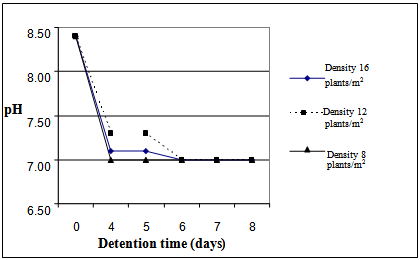 | Figure 1. Parameters of pH on the wetland with Typha latifolia |
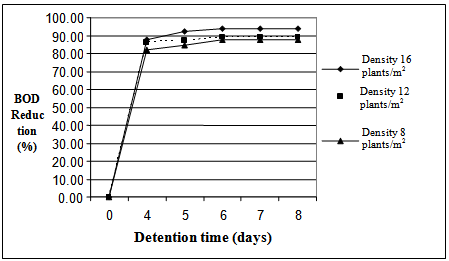 | Figure 2. Reduction of BOD on the wetland with Typha latifolia |
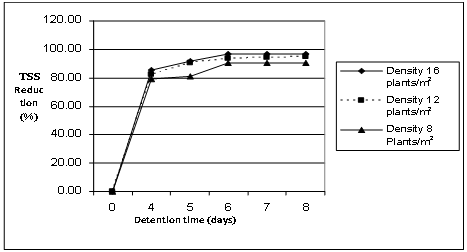 | Figure 3. Reduction of TSS on the wetland with Typha latifolia |
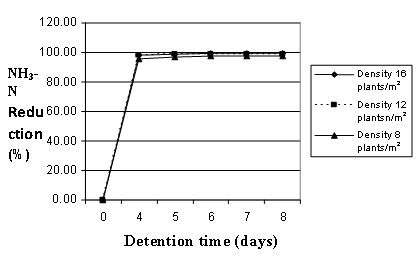 | Figure 4. Reduction of NH3-N on the wetland with Typha latifolia |
It also happens to decrease of NH3-N parameter on Figure 4, NH3-N paremeter decrease also occurred in the largest constructed wetland at a density of 16 plants/m2, where the levels of NH3-N can be reduced up to 99.21% or to 2.5 mg / l . When compared with the quality standards established by The Decree of environment minister No. 112/2003 which is the entire parameter meets quality standards.
3.1.2. Constructed Wetland Planted with Papyrus
Constructed wetland planted with Papyrus shown to neutralize the pH of the wastewater, as shown by Figure 5 initial pH value of 8.4 can be decreased is up to 7.0 on the density of 16 plants/m2 . Decline occurred on BOD parameter of 325 mg / l to 22.4 mg / l at 16 plants/m2 wetland density or by 93.17% as shown in Figure 6. Trend of BOD reduction is proportional to the density of the greater plants. Figure 7 shows that the reduction TSS parameter can reach up to 96.49%. Parameter TSS initial amounted to 310 mg / l can be decreased by wetlands is with Papyrus up to become 11.2 mg / l or approximately 89.19% on the density 16 plants/m2. TSS will be even greater decrease proportional to the increase in plant density.Parameter values initial NH3-N by 55 mg / l can be lowered by up to 2.8 mg / l or by 99.13%, as shown in Figure 8. NH-3N decline also proportional to the density of plants. When compared with the Quality Standards established by the Ministry of Environment No. 112 of 2003 in which all the parameters that it meets quality standards.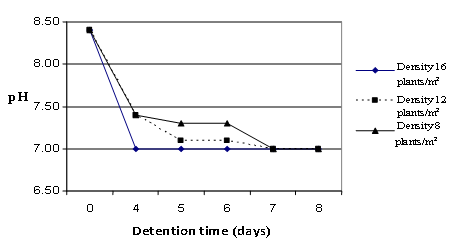 | Figure 5. Parameters of pH on the wetland with Papyrus |
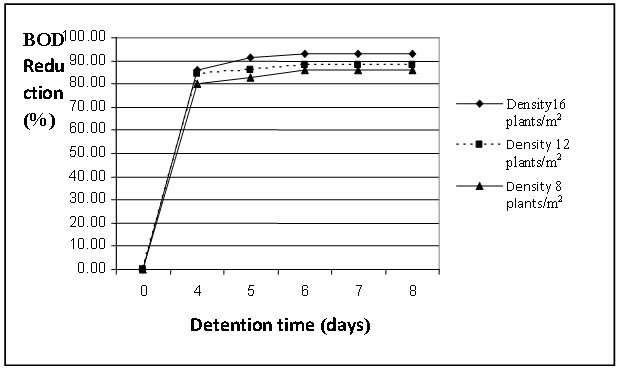 | Figure 6. Reduction of BOD on the wetland with Papyrus |
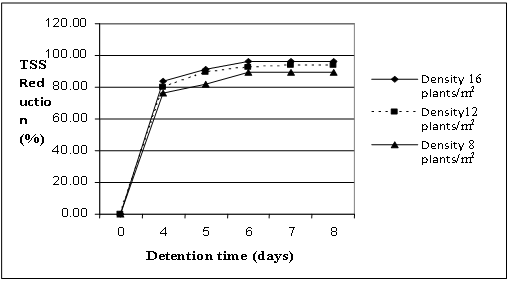 | Figure 7. Reduction of TSS on the wetland with Papyrus |
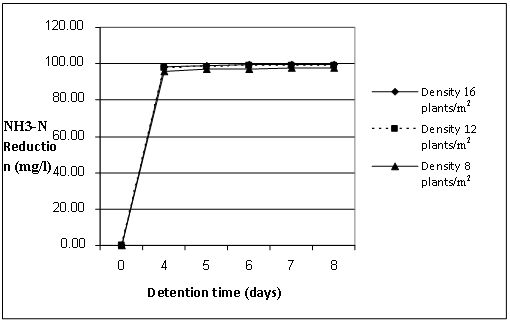 | Figure 8. Reduction of NH3-N on the wetland with Papyrus |
3.1.3. Constructed Wetland Planted with Iris
As happened in the wetland with Typha latifolia and Papyrus plants, wetland with iris also can neutralize the pH value of the wastewater. This can be seen in Figure 9, where the pH value of the waste water can be lowered from 8.4 to 6.9 on the density of 16 plants/m2.In Figure 10 also appears that the greatest BOD impairment occurs in 16 plants/m2 wetland density is equal to 84.62%. The greater the density the greater BOD value that can be decreased. The same thing also happened on the parameters TSS and NH3-N.Figure 11. shows that the wetland with iris can reduce TSS of 310 mg / l down to be 54.5 mg / l or reached 82.74%, while for NH3-N parameters can be decreased from 55.0 mg / l decreased to 16.80 mg / l or reaching 94.84% as shown in Figure 12. The amount of reduction TSS parameters and NH3-N is directly proportional to the density of plants.The third type of plants used in this research (Typha latifolia, Papyrus and Water Orchid) has the same ability to reduce pollutant parameters in wastewater depends on the level of density. It can be concluded that the greater the density, the greater the plant pollutants that can be decreased. Planting density of 16 plants/m2 have the greatest ability to reduce pollutant parameters in wastewater.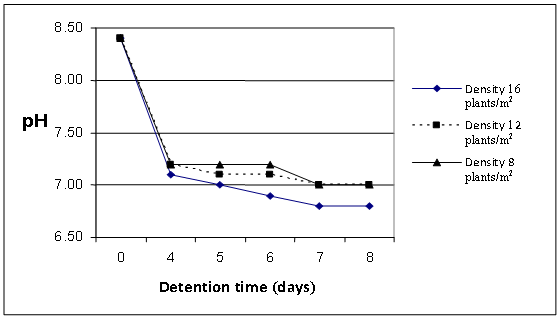 | Figure 9. Parameters of pH on the wetland with Iris |
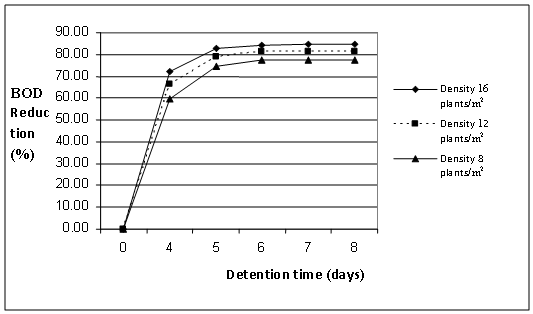 | Figure 10. Parameters of BOD on the wetland with Iris |
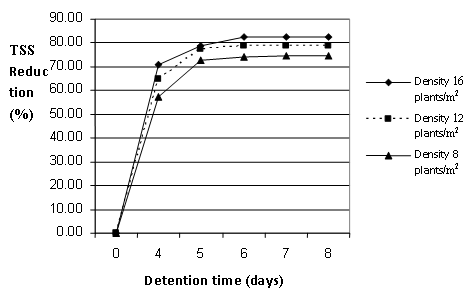 | Figure 11. Parameters of TSS on the wetland with Iris |
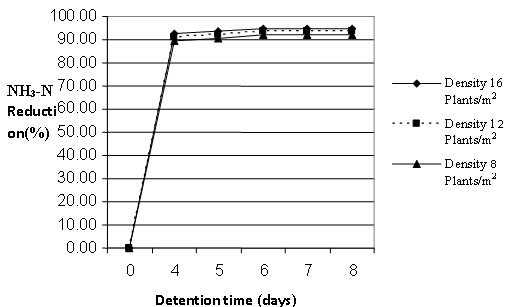 | Figure 12. Parameters of NH3-N on the wetland with Iris |
All types of plants have the same trend, where the pollutant reduction sizable occurred on day 0 to day 4, then reduction starting to stagnate at day 7 and 8. Optimum absorption occurs on days 4 through to 6. It initerjadi because on days 0 plants can not directly absorb pollutants in waste water caused by organic matter is in the form of compounds or molecules that can not be absorbed by plant roots. On day 1 through day 4 a process of decomposition by microorganisms attached to the gravel and plant roots. In the decomposition process occurs reshuffle organic compounds and other molecules. Decomposition in the form of ions and molecules smaller. Ions and molecules will be absorbed by plants as a food source. Process of absorption by the plant will help the soil as a growing medium becomes easily saturated. In addition to absorbing ions and molecules of plants also absorb enough water so that the amount of waste water that comes out to a much reduced wetland effluent.
3.2. Influence of Variations Treatment (Detention time, Initial Density and Type of Plants) to the Absorption Rate of Wastewater Pollutants
In this research variation of the detention time, initial density and types of plants. It aims to determine the effect of these variations on the performance parameters of wetland in the reduce pH, BOD, TSS, and NH3-N. Based on these objectives, the statistical tests performed using analysis of variance (ANOVA) with a confidence level of 95% and a significance level (α) of 0.05 in which C1: detention time factor; C2: initial density factor; C3: plants factor; DB: degrees of freedom; SS: The sum of squares; CS: central squares; F: ratio of the square of the center square of the central sources of error with variation; and P : probability to reject H0. The results of the statistical analysis are as follows:Table 1. Anova of pH reduction
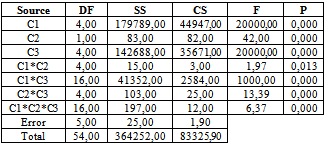 |
| |
|
Variations influence the treatment of wastewater pH neutralization capability can be explained as follows: based on Table 1 is known that the P value of C1 (detention time factor) value is 0.000 which is less than the significance level (α) is equal to 0.05. It can be concluded that the detention time factors affect the pH neutralization. PH neutralization can be achieved in 4 detention time up to 8 days.P values of C2 (initial density factor) and C3 (type of plant) in Table 1 is 0,000 less than the significance level (α) is equal to 0.05. It can be concluded that the initial density and plant species affect the pH neutralization ability. Based on the Table 1 it can be seen that there is interaction between treatment variations, where the value of C1 * C2, C1 * C3, C2 * C3 and C1 * C2 * C3 is smaller than the significance level (α). The ANOVA test results shows that there is an interaction between the factors of the pH neutralization ability.Table 2. Anova of BOD reduction
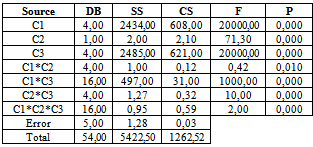 |
| |
|
Variations influence the treatment of BOD reduction can be explained as follows: P values of C1, C2 and C3 in Table 2 respectively is 0.000 which is smaller than the significance level (α) is equal to 0.05. It is clear that all the factors treatment (detention time, initial density and types of plants) affect the BOD allowance. Based on Table 2 also known interaction between treatment variations, where the value of C1 * C2, C1 * C3, C2 * C3 and C1 * C2 * C3 is smaller than the significance level (α). The ANOVA test results shows that there is an interaction between the factors to the decrease BOD.Variations influence the treatment of TSS reduction can be explained by Table 3 with the following data: P values of C1, C2 and C3, respectively is 0.000 which is smaller than the significance level (α) is equal to 0.05. It is clear that all the factors treatment (detention time, initial density and types of plants) a reduction in the TSS. Based on Table 3 also known interaction between treatment variations, where the value of C1 * C2, C1 * C3, C2 * C3 and C1 * C2 * C3 is smaller than the significance level (α). The ANOVA test results shows that there is an interaction between the factors of the allowance TSS.Table 3. Anova of TSS reduction
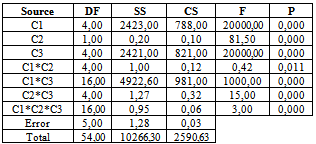 |
| |
|
Variations influence the treatment of NH3-N reduction can be explained by Table 4 with the following data: P values of C1, C2 and C3, respectively is 0.000 which is smaller than the significance level (α) is equal to 0.05. It is explained that all the factors treatment (detention time, initial density and types of plants) a reduction in the NH3-N. Based on Table 4 also known interaction between treatment variations, where the value of C1 * C2, C1 * C3, C2 * C3 and C1 * C2 * C3 is smaller than the significance level (α). The ANOVA test results shows that there is an interaction between the factors of the allowance for NH3-N.Table 4. Anova of NH3-N reduction
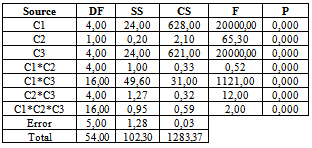 |
| |
|
3.3. Reactor Performance Modelling and Constructed Wetland Design
To obtain the model constructed wetland performance modeling needs to be done mathematically. The mathematical model is formulated based on the results of experimental data. For each type of plant that is used as an experiment has a different mathematical model depends on its ability to absorb pollutants. In this research modeling on the performance parameters of BOD removal (Biologycal Oxygen Demand), this is because BOD is a key parameter in wastewater treatment where BOD impairment will usually be followed by a reduction the value of other parameters. Model performance of each wetland is as follows:1. Constructed wetland with Typha latifolia plants: | (1) |
 | (2) |
 | (3) |
2. Constructed wetland with Papyrus plants: | (4) |
 | (5) |
 | (6) |
3. Constructed wetland with orchids Water: | (7) |
 | (8) |
 | (9) |
In which variable y represents the efficiency that can be achieved by constucted wetland are expressed in percent (%) and x is the detention time is expressed in days. For the purposes of onstucted wetland design, design data set based on the results of research that has been carried out. The recommended minimum detention time: 5 days; Reactor depth: 60 cm; and initial density of plants: 8-16 plants/m2. Detention time and the initial density of plants can be selected according to the desired effluent quality. Effluent quality can be predicted using a mathematical model according to equation 1 to 8 depending on the plants chosen.
4. Conclusions
Conclusions that resulted from this research are as follows:1. Performance of wastewater treatment by constructed wetland system can be described as follows:− Constructed wetlands using Typha latifolia can decrease the pH the wastewater up to 7.00 and BOD loadings can be reduced up to 93.88%, 96.85% TSS and NH3-N 99.21%.− Constructed wetland using Papyrus can decrease the pH the wastewater up to 7.00 and BOD loadings can be reduced up to 93.17%, 96.49% TSS and NH3-N 99.13%.− Constructed wetland using orchids water can decrease the pH the wastewater up to 6.80 and BOD loadings can be reduced up to 84.62%, 82.74% TSS and NH3-N 94.84%.2. Typical data resulted from this research are as follows:− The most effective types of plants from all three types of plants are used as the object of the research is Typha latifolia.− Optimal plant density was 16 plants/m2 for all kinds of variations of plants (Typha latifolia, Papyrus, and Iris).− Optimal detention time is 5 days.
ACKNOWLEDGEMENTS
This research is done in collaboration with the department of settlements in East Java province.
References
| [1] | Pancawardani. Pengolahan limbah dengan tanaman air. 2004. |
| [2] | Steward. Constructed Wetland.Reedbeds International.2007 |
| [3] | Sawyer. Chemistry for Environmental Engineering. McGraw Hill, New York.1994. |
| [4] | Campbell and Ogden. Construdted Wetland For Waste Water. McGraw Hill, New York.1999. |
| [5] | Hammer. Waste Water Engineering. McGraw Hill, New York. 1998 |






















 Abstract
Abstract Reference
Reference Full-Text PDF
Full-Text PDF Full-text HTML
Full-text HTML


